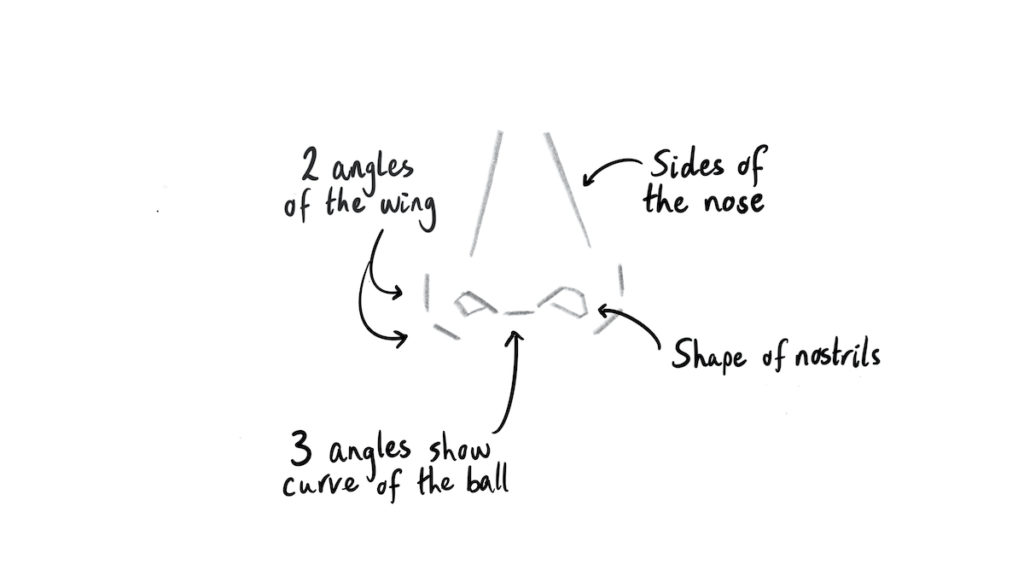How To Draw A Realistic Nose
If you’ve tried to draw a nose before, then you already know that they are one of the most challenging features of the face to draw! In this tutorial, I’ll show you how to draw a nose in four simple steps: Structure, Sketch, Block-in, and Detail.
Drawing supplies for this project:
- 2H pencil (for light sketching)
- 2B pencil (for shading and detail)
- Sketchbook paper
- Eraser (for rubbing out sketch lines)
Optional: Blending stump or Q-tip (for blending shading)
Anatomy Of The Nose
To begin, let’s take a look at the five main parts of the nose so that we know the basics before we start drawing:
- the bridge of the nose
- the ball of the nose
- the wings of the nose
- the nostrils
- the septum

Now let’s work through how to draw a nose step by step. Whether you are a beginner or already drawing faces, this tutorial will take the struggle out of drawing a realistic-looking nose.
Step One: Structure
You’ll see many tutorials teaching you how to draw a nose by starting with three circles. While this is a good way to draw an average nose, it doesn’t help when you want to draw a portrait or a particular nose. Instead, I like to start by finding the unique lines and angles of the nose you are drawing. Think of this as the structural map of a nose. It will help you see how wide or narrow, pointed or upturned, long or short it is. Lightly draw in these angles as straight lines FIRST to avoid drawing a nose that is too rounded or too generic.
The most important angles to look for when drawing a particular nose are:
- The three angles that make up the curve of the ball of the nose
- The angles of the shape of the nostrils
- The two angles of each wing of the nose
- The sides of the length of the nose

Step Two: Sketch Shapes
Now that we’ve drawn a map, we can start to make the nose look more natural. It is important to keep your sketch lines light because there are actually very few outlines on a nose, as we will see in the next step.
Curve off the edges of all the angles. Then add in three ellipses:
- a circular ellipse for the ball of the nose
- an oval ellipse for each wing of the nose

Step Three: Block In Shading
Now it’s time to start shading. But before we do, we need to identify which parts will be lightly shaded and which parts will be shaded dark. When drawing, it’s important to look at things in a different way than you usually would. We are trying to show something that has three dimensions on a two-dimensional surface.
So, how would the nose look as a simple 3-D shape? We can break down the shape of the nose into its main surface planes (any part of the nose that faces a different direction is a “plane”):
- The top plane of the nose
- The bottom plane of the nose
- The two side planes of the nose

Each one of these planes will have a different tonal value, depending on whether it is facing the light or not. Usually, the top of the nose will be very light and have a highlight. We can create this by leaving it the white of the page.
Before you go any further, make sure you erase the sketch lines you no longer need. Then, lightly shade or “block in” any other parts of the nose where the light isn’t hitting directly, like the sides and bottom. Keep it light for now, using only one or two shades of gray. You can always go darker later.

Step Four: Building Detail
In the last step, we started blocking in shading with just one or two values of gray. The key now is to add in three to seven more tonal values ranging from light gray through to black. This will take some patience and some careful looking. Try asking yourself: Which are the lightest parts? Which are the darkest parts? What should be light gray, mid-gray, and dark gray?
Continue shading with light pressure, building up layers of shading that are soft and seamless, like a gray gradient. Just as there are no hard edges on a nose, there should be no hard edges in your drawing!
Try to blend each layer into the one underneath. You can use a blending stump, a cotton bud, or a tissue, to softly blend your gray layers. It’s best to start blending in light areas first and then move to dark areas, not the other way around, so that the light areas don’t become too dark.
Finally, take a last look at your inspiration photo or model to find any areas that are black, and make sure you have the same black tone in your drawing. This will add contrast and 3D form to your drawing.

Things to keep in mind:
- Add key angles as straight lines
- Sketch lightly
- Think of the nose as having four planes
- Block in shading except for highlight areas
- Gradually build up soft layers of dark tone
- Be patient and take your time
Check out the Youtube tutorial to follow along:
I hope you found this tutorial useful! For more portrait drawing techniques, check out this tutorial on How To Draw Realistic Lips.
This article was originally posted on Udemy’s blog : How To Draw A Realistic Nose In Four Simple Steps
